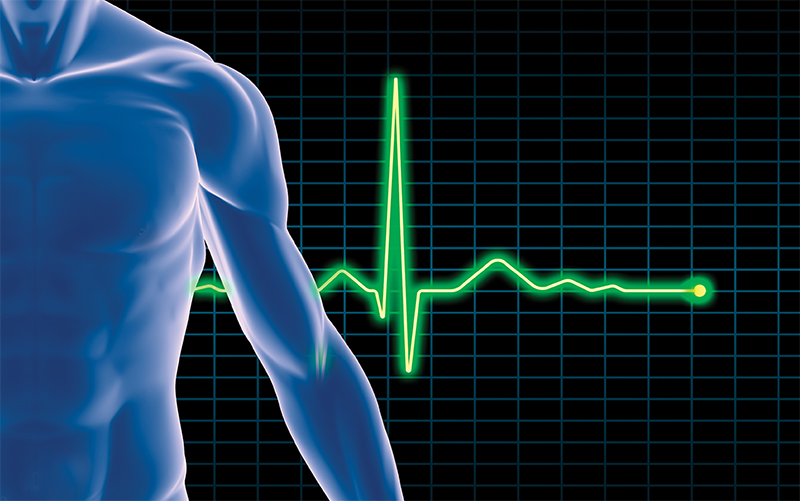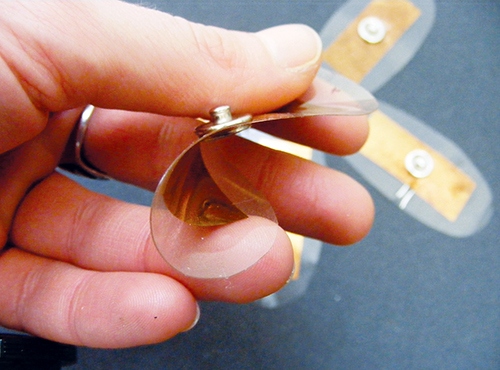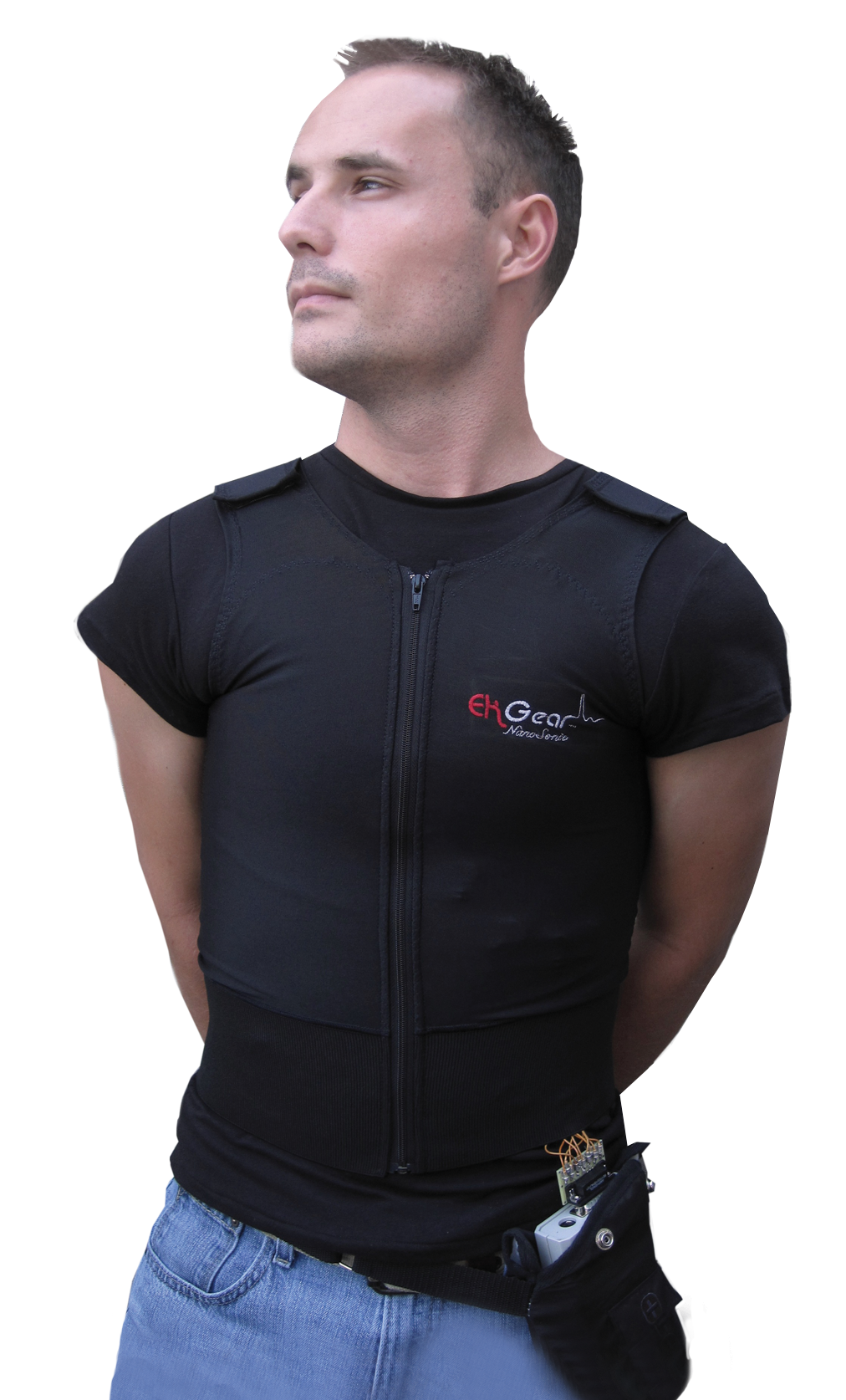
Dry Electrodes Facilitate Remote Health Monitoring
NASA Technology
You wouldn’t find a big bowl of spaghetti served on the International Space Station (ISS). In microgravity, it would be a complete mess. There is, however, something like spaghetti on the ISS: the wires that connect electrodes for an electrocardiogram (EKG). They can be just as much of a nuisance for the crew members.
During a visit to the ISS, an astronaut might experience chest pains or an irregular heartbeat—or might simply want a fitness check-up. Without a doctor’s office or hospital nearby, astronauts perform EKGs themselves to monitor their cardiovascular health. The data is sent to Earth and monitored by a NASA flight surgeon.
The problem with using a conventional EKG machine in space is the electrodes that detect the heart’s signals. First, there is the cumbersome “spaghetti” of wires connecting the electrodes to the EKG device.
“The ‘spaghetti’ flies here and there—it can get hooked on something and yanked off of an individual,” says Todd Schlegel, a medical officer at NASA’s Johnson Space Center.
The electrodes also must be wet to adhere to the skin. Over a period of time, the wires and moisture (or stickiness) make the electrodes uncomfortable for the person wearing them. Lastly, because they are not reusable, supplies of electrodes must be transported to and from space.
“We prefer something streamlined, with no wires flying around,” Schlegel says. “We also want something that is reusable. A dry electrode system that is secured would be very useful.”
Technology Transfer
One of the companies NASA partnered with to make Schlegel’s concept a reality was NanoSonic Inc., based in Pembroke, Virginia. Founded in cooperation with Virginia Polytechnic Institute and State University in 1998, NanoSonic produces a novel technology called Metal Rubber. Flexible like rubber but conductive like steel, the nanotechnology has been the subject of research and development efforts for more than a decade.
Rick Claus, NanoSonic’s president and founder, says, “We found when you stretched Metal Rubber, the resistance changed, so it could be used as a sensor.”
In 2005, NanoSonic was awarded Small Business Innovation Research (SBIR) funding from Johnson Space Center to employ Metal Rubber as a lightweight, comfortable sensor to potentially replace the electrodes and wiring currently used for astronaut health monitoring on the ISS.
Through the partnership, NanoSonic demonstrated the feasibility of using Metal Rubber sensors, as well as their performance. Testing to date has shown the health data gathered by the individual sensors is practically identical to standard sensors. The flexible electrodes have also been incorporated into a shirt, which potentially eliminates the burden of adhering electrodes to an astronaut’s body.
“Without any glue or suction cups, the T-shirt tells you heart rate,” says Claus. “We think it’s an interesting step that we haven’t seen other people take.”
According to Schlegel, NanoSonic’s dry electrode effectively receives signals the way a wet electrode would, thanks to the advanced materials. “The key innovation is the dry electrode sensor,” he says. “I think it’s going to have usefulness in many different applications.”
Benefits
In 2011, NanoSonic started marketing the dry electrode sensors as well as an EKGear Sensor Shirt based on the NASA-derived technology—to automatically measure heart rate and rhythm. According to Andrea Hill, the sensors group leader at NanoSonic, “We get inquiries from large and small companies weekly. There has been a lot of interest from around the world.”
As a reusable, washable, form-fitting remote cardiac monitoring garment, EKGear uses no clips, clamps, external lead wires, or gels. “You don’t have to treat the skin like you do with typical EKG leads. You just slip on the shirt and it’s ready to go,” Hill says.
One difference between the original version of the technology and NanoSonic’s version is that EKGear transmits information wirelessly to a display that is identical to a traditional heart rate and EKG display. “NASA did not want us to focus on any specific wireless system for them because it could interfere with their electronics. But with EKGear, the wearer can now go out for a jog and it will send a signal back to the display,” says Hill.
The company has already sold a variety of its dry electrodes, a few of its EKGear shirts, and is currently in discussions with companies in the space, athletic apparel, and healthcare communities about using the technology in the future.
Especially convenient for remote health monitoring, there is great potential for the technology in the healthcare and sports and fitness industries, in emergency response situations, and in the military. In hospitals, where certain patients require around-the-clock monitoring, EKGear can provide an alternative to traditional wet and wired electrodes. Hospital garment manufacturers are interested in the technology, and NanoSonic has also spoken to the military about developing apparel for soldiers.
Besides EKG sensors, NanoSonic can incorporate additional electronics in the shirt, including temperature sensors, respiration sensors, and antennas for location information. “Beyond EKG measurements, being able to monitor a soldier and know where they are, how they are doing, what their stress level is, and what their heart rate is—would all be beneficial,” Hill says. The same applies to emergency responders like firemen, police, and disaster relief personnel.
Another area where comfortable, dry electrode sensors would be advantageous is scuba diving. The company recently started talking with a commercial manufacturer of dive suits to see if the sensors would be a good fit.
To add even more convenience to the technology, NanoSonic is also developing a wireless interconnect system and app that can be combined with EKGear and the wearer’s electronic device to capture, record, and track cardio and physiological data.
According to Schlegel, “The shirt is just one of many potential configurations.” He finds the electrodes could potentially be used for electromyograms to evaluate and record the electrical activity produced by skeletal muscles, and for electroencephalograms to study the electrical current within the brain.
Metal Rubber™ is a trademark of NanoSonic Inc.
EKGear™ is a trademark of NanoSonic Inc.

The dry electrode may be used in the future to monitor astronauts’ heart health in space. It uses no clips, clamps, wires, or gels, and is being considered for use in the garments patients wear in hospitals, in apparel for athletes and soldiers, and in dive suits for scuba divers.

A shirt that monitors heart rate and EKG.














